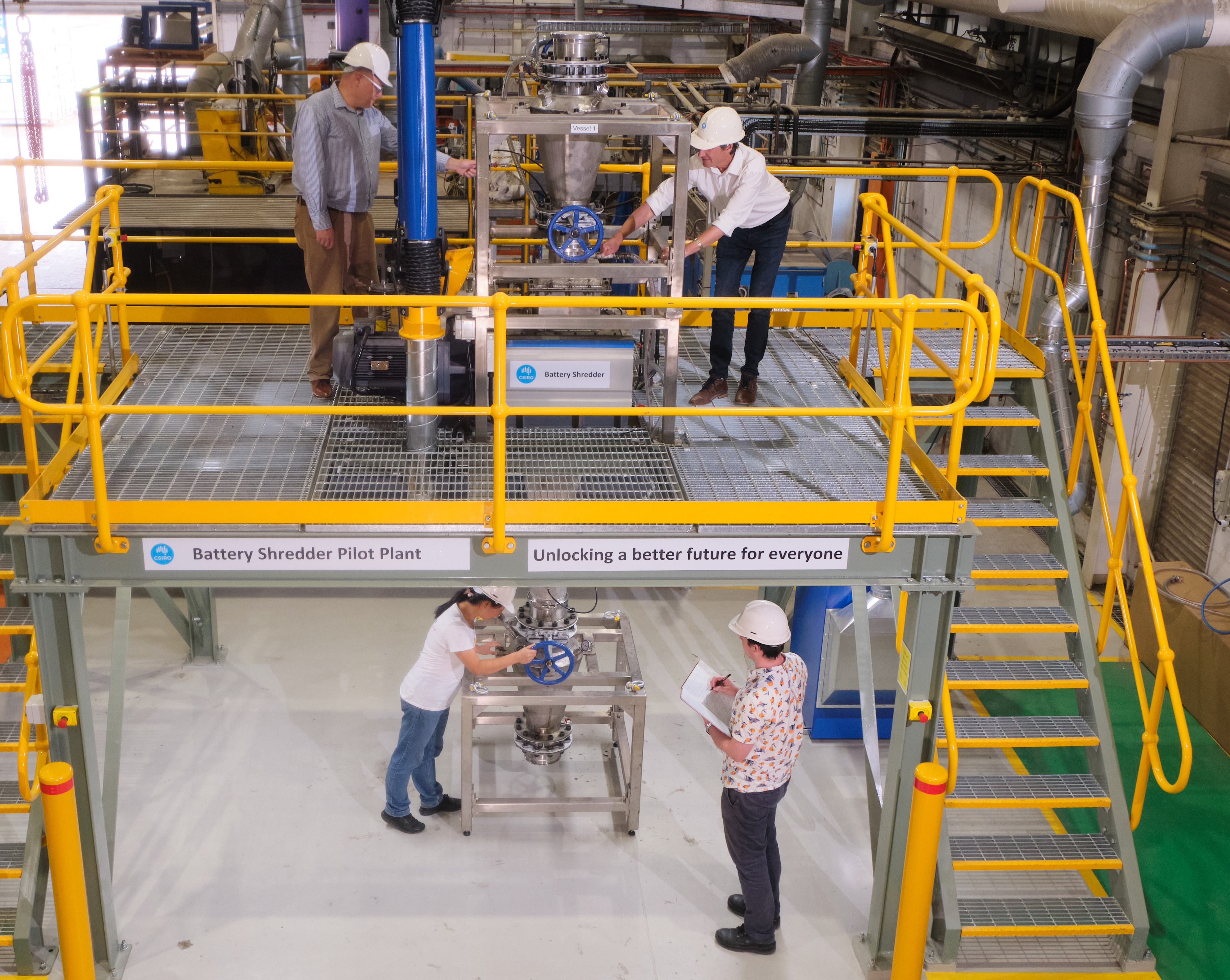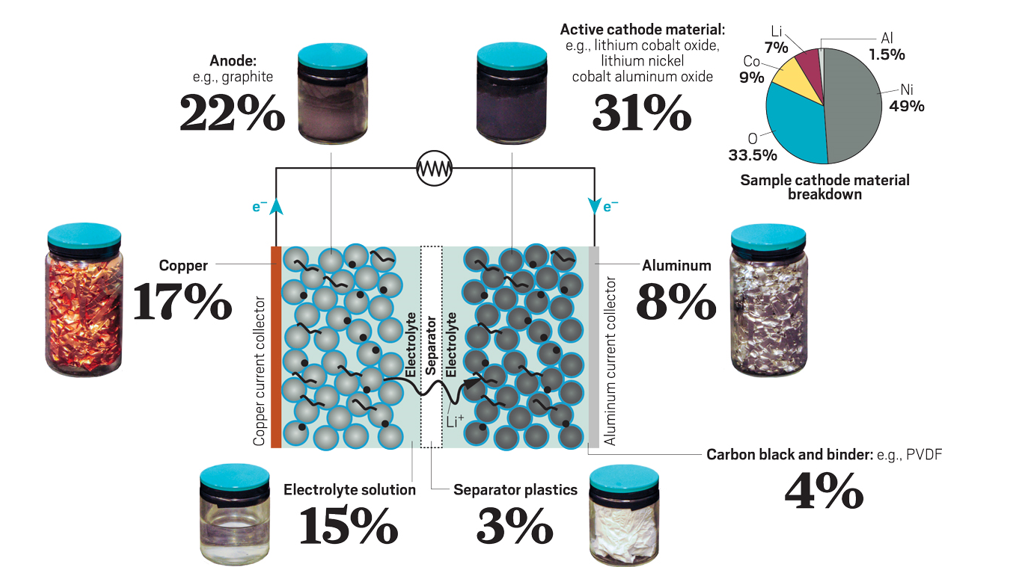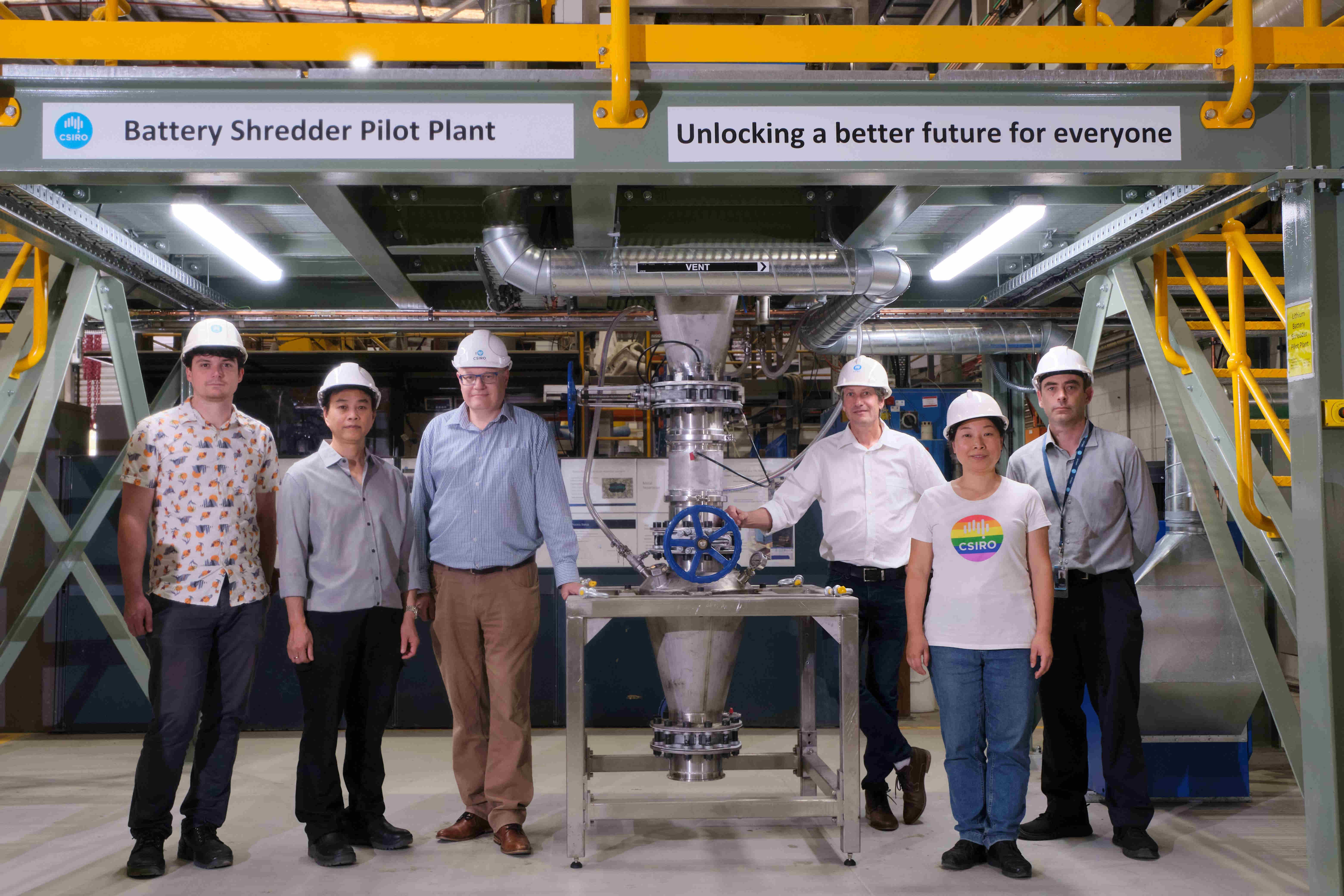From CSIRO-Commonwealth Scientific and Industrial Research Organization (AU)
5.23.24
Thomas Ruether
Ruth Dawkins
Australia’s use of lithium-ion batteries (LIBs) is soaring. Their long lifespan, high efficiency and use across an increasing range of applications present benefits for consumers. But as demand grows, so too does the question of how we safely manage this waste stream.
_________________________
Key points
-Australia’s use of lithium-ion batteries (LIBs) is soaring, raising questions about managing the growing waste stream.
-Our researchers are testing the dry shedding of used LIBs, using a novel process to recover valuable materials.
-Insights from the pilot will be important for improving global battery recycling practices as we transition to net zero emissions by 2050.
_________________________
It’s a problem that our researchers across energy, minerals and manufacturing have been working hard to solve. Now, a recently constructed pilot facility for recycling LIBs is helping uncover crucial insights. Their discoveries have the potential to make the process much safer – not just in Australia but around the world.

Australia produces around 3,300 tonnes of lithium-ion battery waste each year. © Nick Pitsas
Managing the challenges of lithium-ion battery waste
While it’s possible to recycle LIBs at the end of their service life, it’s a complex and costly process. As of 2021, only about 10 per cent of Australia’s LIBs were being recycled. Globally, that figure is about five per cent.
There are several programs working to promote the collection, recycling and safe disposal of all batteries. These include the Australian Battery Recycling Initiative, of which we are a member, but there is a long way to go before LIBs reach the 98 per cent recycling rate that has been achieved for lead acid batteries.
Dr Thomas Ruether is a Senior Research Scientist and Team Leader with the Electrochemical Energy Storage team in our Energy Technologies Program. He says there are very, very few places in Australia that do LIB recycling.
“Due to government subsidies, enabling regulatory frameworks and larger volumes of end-of-life LIBs, about 90 per cent of the world’s recycling capacity is located in Asia and Europe, with a small amount also taking place in the US,” Thomas says.
“Previously, it was common practice in Australia to package our battery waste up and ship it overseas. However, this has become increasingly difficult because of the risks of end of service life LIBs. Much of it is now just warehoused by private industry.”
Costs and complexities for domestic recycling efforts
Low recycling rates pose several different problems. If LIBs are not properly disposed of, there is risk that harmful materials may leach out of landfill sites resulting in environmental and health issues. Large, concentrated volumes of batteries stored in warehouses or scrap yards need careful management. This is due their flammable electrolyte systems and potential environmental contamination.
There are also sustainability considerations given LIBs contain concentrated high-value critical metals and minerals. If we don’t recycle lithium-ion batteries, the valuable materials they contain are forgone. A shame when many of these materials can be reused in new batteries or repurposed for other applications. New raw materials will then have to be mined (which may be comparatively more economic to source).
In response to these challenges, our report – Australian Landscape for Lithium-Ion Battery Recycling and Reuse in 2020 – identified a range of opportunities across research, industry development, policy and regulation, to strengthen and grow Australia’s domestic recycling capability.
We are currently engaged in several of these research opportunities. They address battery fire safety risks during collection, transportation, and storage. Additionally, there is a focus on research and development to support recycling lithium-ion batteries into high-value products. This includes second life reuse applications, economic recovery and utilization of battery electrolyte and graphite, and environmentally friendly recovery of battery metals.
Current battery recycling practices
When LIBs reach their end of service life and are collected for recycling, the initial step of the process is to shred them into smaller pieces for further processing.
Thomas reviewed battery market and recycling trends in a paper he co-authored in 2021, published in the Sustainable Chemistry journal.
“LIBs are processed to a point where you recover what’s called Black Mass,” Thomas says.
“Black Mass is essentially graphite and metal oxides – the electrode materials – mixed together in a powder. It can be safely exported offshore for further processing to recover lithium, cobalt and nickel.”
Depending on the processes used, between 50 per cent and 95 per cent of the materials contained in LIBs can be recovered. While the shredding of LIBs is routinely practiced in the recycling industry, there are still significant safety concerns and many unknowns relating to the risk of fire and explosion. There is also the potential release of toxic compounds.
Traditional aqueous wet shredding utilizes a submerged setting with a brine solution. To mitigate some of these risks, progressive recycling operations are moving away from aqueous wet shredding. Instead, they’re opting for dry shredding under an inert gas blanket to keep air-oxygen out. The dry method also provides the benefit of recovering more recyclable material of value, safely.
For example, electrolyte salt is a small but valuable component of a battery. It represents about two to three per cent of the electrolyte solution that makes up 15 per cent of a battery cell mass. However, it accounts for more than 60 per cent of the electrolyte solution cost.
In a wet shredding environment, the electrolyte solution reacts with water and decomposes. This results in toxic corrosive gas which needs significant effort to manage. However, in dry shredding it can be safely separated and potentially recovered.

Lithium-ion batteries contain many different valuable materials. © Republished with permission from Chemical & Engineering News. Copyright ©2019 by the American Chemical Society
Innovations in LIB recycling technology
Improving the safety of LIB recycling – and increasing Australia’s capacity to undertake such processes – is an urgent priority. Our researchers are focused on two key areas.
“The first big problem for recyclers is the difficulty of determining what state of charge a battery is in,” Thomas says.
“When LIBs come into a recycling facility for processing, they usually contain residual energy. This presents a significant hazard. If you get a short circuit, or they get damaged, they can cause a fire or explosion.”
To address this, Thomas’ team has worked in partnership with an e-waste recycler. They aim to develop an electrical discharge unit that allows for the safe and controlled discharging of batteries. The project is funded by the New South Wales Government EPA

Our battery recycling team: Oliver Pohl, Owen Lim, Andreas Monch, Thomas Ruether, Yanyan Zhao and Adam Christensen
“During the discharge process you can develop heat, and you need to avoid the batteries going into a thermal runaway reaction,” Thomas says.
A thermal runaway reaction leads to rapid temperature and pressure increase, often causing fire or an explosion.
“We monitor the temperature, current and voltage during the discharge process to ensure the discharge takes place in a controlled manner.”
The second area of focus involves collecting data on the performance of dry shredding systems at an industrial scale and identifying operational limitations for safe processing.
Thomas’ team has commissioned a pilot facility at our Clayton site for the safe dry shredding of LIBs under an inert nitrogen gas atmosphere (N2).
The plant, which can handle up to 10-kilogram batches of batteries, is a first of its kind in Australia. It is equipped with several technical features such as optical and thermal (IR) cameras, an additional airtight port for injecting single battery cells, and the ability to measure and clean the exhaust gases emitted from the process. It also includes a novel process to recover lithium electrolyte salt using the dry shredded material as a pure crystal which can be used for making new batteries. Patent protection is being sought for the process.
Our battery shredder breaking apart a battery under an inert gas blanket.
“The plant is ideally suited to on-site monitoring and data collection during the processing of LIBs,” Thomas says.
“We can do optical and thermal monitoring of what’s occurring in the shredding chamber. So, you can see very clearly on the video footage what can happen depending on how much energy is left in the batteries.”
“These insights into what takes place during the dry shedding process are hugely important. Not just to our own research and process development, but also to the battery recycling industry globally as they address serious safety concerns and many unknowns concerning materials integrity and their further downstream processing.”
See the full article here .
Comments are invited and will be appreciated, especially if the reader finds any errors which I can correct.

five-ways-keep-your-child-safe-school-shootings
Please help promote STEM in your local schools.
CSIRO-Commonwealth Scientific and Industrial Research Organization (AU ), is Australia’s national science agency and one of the largest and most diverse research agencies in the world.
CSIRO works with leading organizations around the world. From its headquarters in Canberra, CSIRO maintains more than 50 sites across Australia and in France, Chile and the United States, employing about 5,500 people.
Federally funded scientific research began in Australia over 100 years ago. The Advisory Council of Science and Industry was established in 1916 but was hampered by insufficient available finance. In 1926 the research effort was reinvigorated by establishment of the Council for Scientific and Industrial Research (CSIR), which strengthened national science leadership and increased research funding. CSIR grew rapidly and achieved significant early successes. In 1949 further legislated changes included renaming the organization as CSIRO.
Notable developments by CSIRO have included the invention of atomic absorption spectroscopy; essential components of Wi-Fi technology; development of the first commercially successful polymer banknote; the invention of the insect repellent in Aerogard and the introduction of a series of biological controls into Australia, such as the introduction of myxomatosis and rabbit calicivirus for the control of rabbit populations.
Research and focus areas
Research Business Units
As at 2019, CSIRO’s research areas are identified as “Impact science” and organized into the following Business Units:
Agriculture and Food
Health and Biosecurity
Data 61
Energy
Land and Water
Manufacturing
Mineral Resources
Oceans and Atmosphere
National Facilities
CSIRO manages national research facilities and scientific infrastructure on behalf of the nation to assist with the delivery of research. The national facilities and specialized laboratories are available to both international and Australian users from industry and research. As at 2019, the following National Facilities are listed:
Australian Animal Health Laboratory (AAHL)
Australia Telescope National Facility – radio telescopes included in the Facility include the Australia Telescope Compact Array, the Parkes Observatory, Mopra Radio Telescope Observatory and the Australian Square Kilometre Array Pathfinder.








CSIRO Pawsey Supercomputing Centre AU)




Others not shown
Collections
CSIRO manages a number of collections of animal and plant specimens that contribute to national and international biological knowledge. The National Collections contribute to taxonomic, genetic, agricultural and ecological research. As at 2019, CSIRO’s Collections are listed as the following:
Australian National Algae Culture Collection
The Atlas of Living Australia
Australian Tree Seed Centre
Australian National Fish Collection
Australian National Insect Collection
Australian National Herbarium
Australian National Soil Archive (managed through A&F)
Australian National Wildlife Collection
Cape Grim Air Archive
Services
In 2019, CSIRO Services are itemized as follows:
Materials and infrastructure services
Agricultural and environmental analysis
Environmental services
Biological, food and medical science services
Australian Animal Health Laboratory services
Other services are noted as including education, publishing, infrastructure technologies, Small and Medium Enterprise engagement and CSIRO Futures.
Inventions
Notable inventions and breakthroughs by CSIRO include:
A4 DSP chip
Aerogard, insect repellent
Atomic absorption spectroscopy
Biological control of Salvinia
Development of Linola (a flax variety with low alpha-linolenic acid content) with a longer life used as a stockfeed
Distance measuring equipment (DME) used for aviation navigation
Gene shears
Interscan Microwave landing system, a microwave approach and landing system for aircraft
Use of myxomatosis and calicivirus to control rabbit numbers
Parkes Radio Telescope
The permanent pleat for fabrics
Plasma sintering
Polymer banknote
Production of metals from their halides
Relenza flu drug
Sirosmelt lance
“Softly” woollens detergent
Phase-contrast X-ray imaging
Method to use titanium in 3D printing
UltraBattery
Essential components of Wi-Fi technology
Zebedee – Mobile Handheld 3D Lidar Mapping technology
Historic research
CSIRO had a pioneering role in the scientific discovery of the universe through radio “eyes”. A team led by Paul Wild built and operated (from 1948) the world’s first solar radiospectrograph, and from 1967 the 3-kilometre-diameter (1.9 mi) radioheliograph at Culgoora in New South Wales. For three decades, the Division of Radiophysics had a world-leading role in solar research, attracting prominent solar physicists from around the world.
CSIRO owned the first computer in Australia, CSIRAC, built as part of a project began in the Sydney Radiophysics Laboratory in 1947. The CSIR Mk 1 ran its first program in 1949, the fifth electronic computer in the world. It was over 1,000 times faster than the mechanical calculators available at the time. It was decommissioned in 1955 and recommissioned in Melbourne as CSIRAC in 1956 as a general purpose computing machine used by over 700 projects until 1964. The CSIRAC is the only surviving first-generation computer in the world.
Between 1965 and 1985, George Bornemissza of CSIRO’s Division of Entomology founded and led the Australian Dung Beetle Project. Bornemissza, upon settling in Australia from Hungary in 1951, noticed that the pastureland was covered in dry cattle dung pads which did not seem to be recycled into the soil and caused areas of rank pasture which were unpalatable to the cattle. He proposed that the reason for this was that native Australian dung beetles, which had co-evolved alongside the marsupials (which produce dung very different in its composition from cattle), were not adapted to utilise cattle dung for their nutrition and breeding since cattle had only relatively recently been introduced to the continent in the 1880s. The Australian Dung Beetle Project sought, therefore, to introduce species of dung beetle from South Africa and Europe (which had co-evolved alongside bovids) in order to improve the fertility and quality of cattle pastures. Twenty-three species were successfully introduced throughout the duration of the project and also had the effect of reducing the pestilent bush fly population by 90%.







